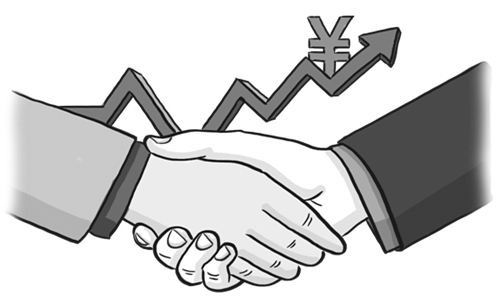HOME >> SOURCE
China-US trade ties return to normalcy; yuan’s rise worth watching
By Wen Sheng Source:Global Times Published: 2020/1/16 20:46:57

Illustration: Xia Qing/GT
The inking of the phase one trade deal between China and US has called a truce in the two-year, crippling trade conflict between the world's two largest economies. The détente will set the pace for lowered tariffs, trade revival and a gradual normalization of the previously disrupted global supply chain - steps that are desired by the global community.The achievement of the phase one deal following a protracted tussle since early 2018 is upbeat news for the two economic powers. Yet the phase one agreement is still not sufficient, as many biting tariffs remain. The world is obliged to ask for more.
If the US government agrees to cancel all tariffs and China abolishes its retaliatory taxes, both economies and the global economy as a whole will benefit significantly. For US President Donald Trump, a revitalized and humming economy will be the best anchor for him to secure a presidential reelection in November. The odds are good that he will take the initiative to abolish all additional duties his government has imposed on China and other countries since 2018.
China has agreed to import more US agricultural products, energies, manufactured goods and services - some put the overall import value at $100 billion a year - a move that will work to rebalance the country's bilateral trade with the US. These massive purchases, plus the Chinese market's penchant for goods made by a wide range of US technology companies, is set to boost the US economy and will probably help it avert a recession in 2020.
China, the world's largest trader, has the appetite to consume the incrementing imports from the US. Also, the abundance of imported US goods will assist the country in reining in meat-price hikes and curbing rising inflationary pressure. The consumer price index for November and December exceeded 4 percent, drawing grievances from the middle class and those in poverty.
Even amid the trade war, China's economy has proven remarkably resilient. Chinese people's vast consumption power, Beijing's steadfast infrastructure investment and highly dynamic, internet-based technology innovations are the bedrocks of the stabilizing economic growth.
As the phase one trade deal is inked and will soon come into force, China's foreign trade will be pushed back onto the fast lane. Entering 2020, we have reason to be upbeat as the world's two largest economies return to better terms.
Some Chinese pundits are jittery that there may be difficulties for China when absorbing the flood of US products. Others say that Japan was once in China's current position. In the 1980s, Japan was forced to accept the Plaza Accord, which saw the value of the Japanese yen skyrocket against the dollar. As a result, Japan's export-driven economy was brought to the ground, and the country has never recovered.
Now, China's currency, the yuan, is rapidly rising in value against the dollar and other currencies. Therefore, China's central bank ought to watch the dynamics of the global currency market closely, and intervene when necessary to stop any drastic rise of the yuan in the short term. Sharp currency appreciation will create heavy headwinds for China's exports and dent its sprawling manufacturing sector - a sector that cannot lose to peers in other countries.
The author is an editor with the Global Times. bizopinion@globaltimes.com.cn
Posted in: COLUMNISTS